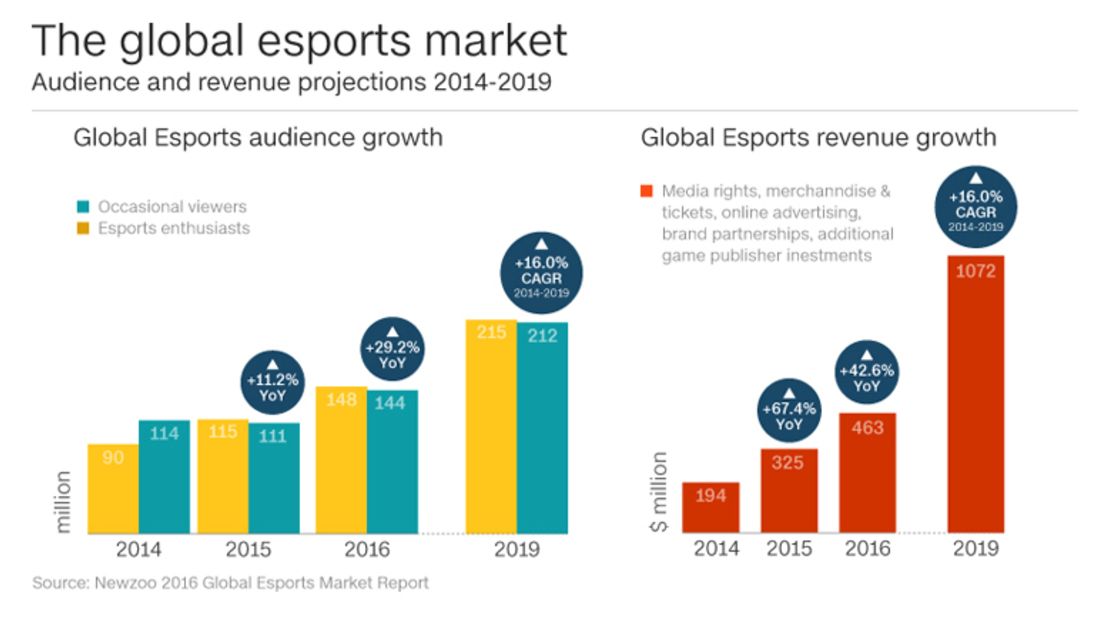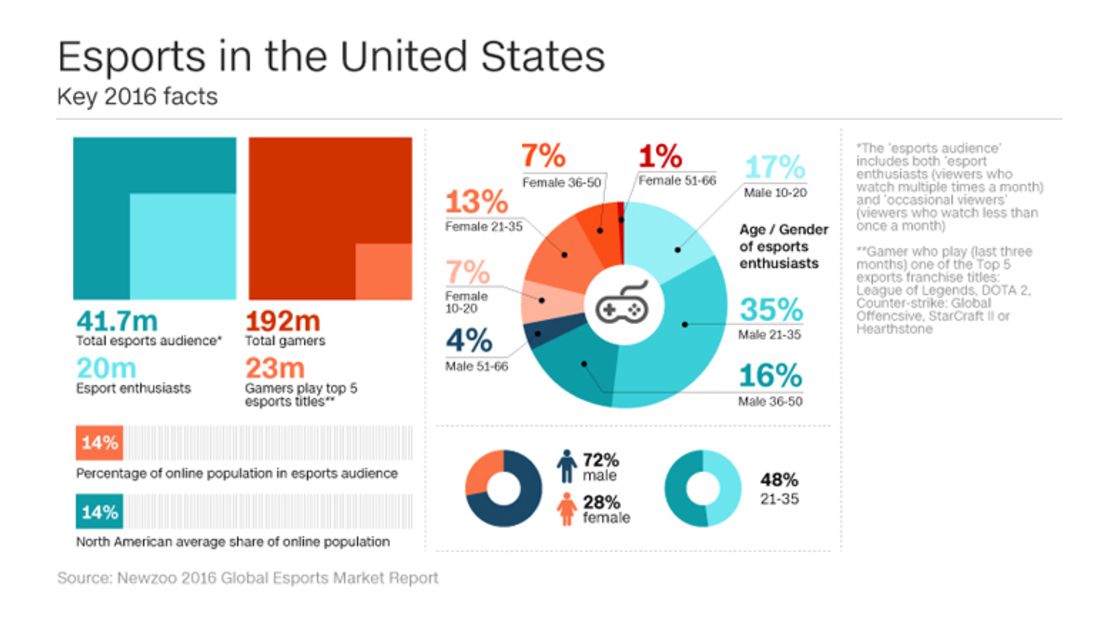Story highlights
eSports is a potential $1B industry
Leading player says will "be as big as NHL"
Team boss says "stereotypical gamer is dead"
Also hit by match-fixing, doping and injuries
Hordes of fans queue outside, eagerly awaiting a glimpse of their heroes.
Inside, a shining trophy stands upon a pedestal. The players arrive, eyeing it covetously as they make their way to their positions.
Suited pundits have had their say and hand over to the commentators.
One team forms a pre-match huddle; the other waits patiently for the game to commence.
A stirring light show ceases; a chanting crowd falls to an expectant hush.
But this isn’t the Champions League final. This isn’t Wimbledon. This isn’t the Super Bowl.

A new game
This is eSports, dubbed by data analytics service Newzoo as the “biggest thing to hit (the tech) industry since the launch of the iPhone in 2007.”
In South Korea, stadiums once used to host football matches at the 2002 FIFA World Cup are now frequently packed to capacity with eSports fans, looking on as a new generation of heroes wields keyboard and mouse.

According to Newzoo, the eSports global audience grew from 204 million to 292 million between 2014 and 2016 – a 43% increase in just two years – and it’s projected to exceed 427 million around the world by 2019.
Global revenue in the eSports industry rose from $194 million to $463 million in the same period – a 239% increase – and is expected to smash $1 billion by 2019.
“In 10 years’ time, it will be as big as NHL,” leading gamer Olof Kajbjer tells CNN.

He’s not the only one with grandiose aspirations. Carlos “ocelote” Rodriguez, founder of G2 Sports, regards his “premier eSports club” as “Real Madrid on a smaller level.”
If such comparisons feel a little false, it’s worth noting eSports participants now qualify for a US p-1 Visa, henceforth reserved for professional athletes – “a watershed moment,” according to Dustin Beck, vice-president of eSports at Riot Games.
Back to you in the studio
But the entrepreneurs and gamers are not the only ones shouting from the rooftops about this multimillion-dollar industry.
“Shoutcasters” – ESports commentators – “add that special touch to it,” just as they do in traditional sports broadcasting, according to Shaun Apollo Clark.
Clark routinely studies the players – “not just the way they play the game but the way they live” – to ensure eSports is a “complete” spectator sport.
Stadiums packed with partisan fans and gaming stars are now cropping up in England, Poland and Germany.
“It’s the same as if you go to a football match and you’re jumping up and down,” Clark says. “You enjoy the moment with people you don’t even know. It stays with you.
“Ten years ago I was playing in front of an audience of five people as a pro player. The next 10 years in eSports? I would say that’s the next 100 years in real sports.”
Hallmarks of conventional sport?
The global audience, revenue and ambition of eSports are hardly in doubt, then – but these are not necessarily the hallmarks of conventional sport. What of the elements of competition, entertainment and skill?
Sam Mathews, founder of Fnatic – which lists itself as a “Sports Team” on Facebook and has over 2.5 million likes – tells CNN that he defines eSports “as competition augmented by technology.”
“ESports really are highly strategic,” Mathews says. “It can be up to 10, 12 hours a day of gaming just to perform that one movement or skill shot better.”
“We have a live-in coach, we have analysts, we have … basically a huge support network.”
The general consensus is that if physical exertion and sheer power are dispelled, reflexes and mental agility come to the fore.
Still, mindful of the saying that a healthy body is a healthy mind, many professionals spend hours in the gym to help keep their brains sharp.
The desire to be the best manifests itself in eSports just as it does in traditional sports, according to “Yellowstar,” a leading League of Legends player.
“If you perform, you are going to receive a lot of praise,” he explains. “If you were to miss or fail an action, you can bring your team down, affect your team’s performance and get a lot of blame.”
No wonder certain players hit 500 APM (actions per minute) on popular game Starcraft 2 – over eight per second.
These aren’t just kids playing video games.
“The stereotypical gamer is dead,” according to Fnatic’s chief gaming officer Patrik Sattermon.
Injuries and scandals
Just as in conventional sport, “you need storylines, you need personalities,” muses Mathews, founder of Sattermon’s team.
If sport is narrative, the eSports story is only just beginning. The Fnatic team refer to Sattermon as “our Sir Alex Ferguson” – the former all-conquering Manchester United manager.
But convergence with the big boys has brought a concomitant set of issues.
Fully-fledged stats are not yet available, but according to Newzoo, gaming injuries are “a gradually growing problem, and something that the teams are trying to combat by hiring relevant staff as well as with education.”
With so much money at stake, there have also been match-fixing and doping scandals in recent years.
An independent regulatory board, WESA, has consequently been established.
WESA claims it will “further professionalize eSports by introducing elements of player representation, standardized regulations, and revenue sharing for teams.”
X-Games
It’s worth pointing out that extreme sports – perhaps the very opposite of a teen spending 16 hours in a darkened room playing “Dungeons And Dragons” – faced similar skepticism when they began to receive consistent press coverage in the early 1990s.
The X-Games (the Olympics of extreme sports) has grown from small beginnings, and many of the sports it features, like snowboarding, have since played a large part at the official Winter Games.
An idea that seemed a pipe dream now looks an inevitable ascension and, curiously enough, it’s gone full circle: eSports is now appearing in the X-Games.
Looking forward
Whether it’s deemed a sport or not by the mainstream media ultimately seems of little concern to the average eSports fan.
What’s striking is that while conventional sports reflect back upon grand times gone by, eSports fans, commentators and players are only looking forward.
“When I was very young I used to watch Formula One, football and tennis with my father,” says Rodriguez. “Maybe when I have my son, he’s going to watch football, Formula One and eSports.”
READ MORE: The ‘geek tree-hugger’ leading eSports’ rise
What do you think of eSports? Have your say on our Facebook page
















